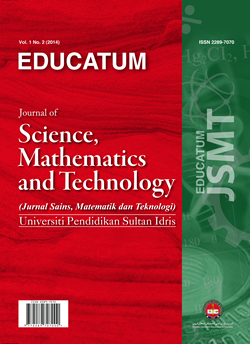The Effects of Reading on Tear Stability in Soft Contact Lens Wearer
DOI:
https://doi.org/10.37134/ejsmt.vol9.2.10.2022Keywords:
Contact lenses, non-invasive tear break up, reading, tear film stabilityAbstract
This study aimed to determine the effects of reading on non-invasive tear break-up time (NIBUT) in soft contact lens wearers and establish the correlation between the Contact Lens Dry Eye Questionnaire-8 (CLDEQ-8) and the NIBUT before and after reading. The demographic questionnaire, Contact Lens Dry Eye Questionnaire-8 (CLDEQ-8), were completed by 18 soft contact lens wearer (36 eyes; 17 females and 1 male). The NIBUT was measured as a baseline using modified bowl perimetry before reading. The subjects were then instructed to read silently for 20 minutes a validated hard copy text. The NIBUT test was administered again following the reading task. This study enrolled a total of 18 contact lens wearers (36 eyes). The mean age of the participants was 22.89 ± 1.687 years, and the mean refractive power of their contact lenses ranged from Plano to -5.75D (1.44 ± 0.504D). Twenty-five eyes (55.6%) of contact lens wearers wore lenses less than -3.00D, while sixteen eyes (44.4%) wore lenses greater than -3.00D. The mean of pre-NIBUT and post-NIBUT were 6.43 secs (SD;1.250) and 3.22 secs (SD;0.964) respectively. The paired t-test revealed a significant difference between pre and post-NIBUT; p< 0.001. CLDEQ-8 had a negative poor correlation with pre-NIBUT (r = -0.266) and post-NIBUT (r = -0.150). The values of NIBUT decreased in soft contact lens wearers after a 20-minute near-reading task. Sustained 20 minutes of reading affects the tear stability, resulting in disruption of the tear film layer, which results in tear film instability as measured by CLDEQ-8 and NIBUT before and after reading. There was little correlation between CLDEQ-8 and NIBUT scores before and after reading.
Downloads
References
Jeong, H. (2012), "A comparison of the influence of electronic books and paper books on reading comprehension, eye fatigue, and perception", The Electronic Library, Vol. 30 No. 3, pp. 390-408.
Zickuhr, K., & Rainie, L. (2014). Younger Americans’ reading habits and technology use. Pew Internet Group.
Wolkoff, P., Nøjgaard, J. K., Troiano, P., & Piccoli, B. (2005). Eye complaints in the office environment: Precorneal tear film integrity influenced by eye blinking efficiency. Occupational and Environmental Medicine, 62(1), 4–12. https://doi.org/10.1136/oem.2004.016030
Masakazu Hirota, Hiroshi Uozato, Takushi Kawamorita, Yuko Shibata, and S. Y. (2013). Effect of Incomplete Blinking on Tear. Optometry and Vision Science, 90(7), 650–657.
A Abusharha, A. (2017). Changes in blink rate and ocular symptoms during different reading tasks, 133–138.
Doane, M. G. (1980). Interaction of eyelids and tears in corneal wetting and the dynamics of the normal human eyeblink. American Journal of Ophthalmology, 89(4), 507–516.
Jansen, M. E., Begley, C. G., Himebaugh, N. H., & Port, N. L. (2010). Effect of contact lens wear and a near task on tear film break-up. Optometry and Vision Science, 87(5), 350–357.https://doi.org/10.1097/OPX.0b013e3181d951df
Karakus, S., Agrawal, D., Hindman, H. B., Henrich, C., Ramulu, P. Y., & Akpek, E. K. (2018). Effects of Prolonged Reading on Dry Eye. Ophthalmology, 1–7. https://doi.org/10.1016/j.ophtha.2018.03.039
Craig, J. P., & Downie, L. E. (2018). Tears and Contact Lenses. Contact Lenses (Sixth Edit). Elsevier Inc.
Alonso-Caneiro, D., Iskander, D. R., & Collins, M. J. (2009). Tear film surface quality with soft contact lenses using dynamic-area high-speed videokeratoscopy. Eye and Contact Lens, 35(5), 227–231.
Nichols, J. J., & Sinnott, L. T. (2006). Tear film, contact lens, and patient-related factors associated with contact lens- related dry eye. Investigative Ophthalmology and Visual Science,47(4), 1319–1328.
Roshani, S. (2011). The effect of ocular surface conditions on blink rate and completeness.Master Thesis, 1–115
Chalmers, R. L. B. C., Moody, K., & Hickson-Curran, S. (2012). Contact lens dry eye Questionnaire-8 and overall opinion of contact lenses. Optom Vis Sci, 89(10), 1435–1442.
Dartt, D. A., & Willcox, M. D. P. (2013). Complexity of the tear film: Importance in homeostasis and dysfunction during disease. Experimental Eye Research, 117, 1–3.
Murube, J. (2009). Basal, reflex, and psycho-emotional tears. Ocular Surface, 7(2), 60–66. https://doi.org/10.1016/S1542-0124(12)70296-3
Palakuru, J. R., Wang, J., & Aquavella, J. V. (2007). Effect of blinking on tear dynamics. Investigative Ophthalmology and Visual Science, 48(7), 3032–3037.
Cardona, G., García, C., Serés, C., Vilaseca, M., & Gispets, J. (2011). Blink rate, blink amplitude, and tear film integrity during dynamic visual display terminal tasks. Current Eye Research, 36(3), 190–197.
Cho, P., Cheung, P., Leung, K., Ma, V., & Lee, V. (1997). Effect of reading on non-invasive tear break-up time and inter- blink interval. Clinical and Experimental Optometry, 80(2), 62–68.
Papas, E., Tilia, D., McNally, J., & de la Jara, P. L. (2015). Ocular discomfort responses after short periods of contact lens wear. Optometry and Vision Science, 92(6), 665-670.
Ammer, R. (2017). Effect of Contact Lens Wear on Tear Film Break up Time (TBUT) among Contact Lens Users. Pakistan Journal of Ophtalmology, 33(3), 182–186.
Ewen King-Smith, P., Reuter, K. S., Braun, R. J., Nichols, J. J., & Nichols, K. K. (2013). Tear film breakup and structure studied by simultaneous video recording of fluorescence and tear film lipid layer images. Investigative Ophthalmology and Visual Science, 54(7), 4900–4909.
Rohit, A., Willcox, M., & Stapleton, F. (2013). Tear lipid layer and contact lens comfort: A review. Eye and Contact Lens,39(3),247–253.
Downloads
Published
Issue
Section
License
Copyright (c) 2022 Nur Aresya Ahmad Najmee , Fatin Hazirah Halim

This work is licensed under a Creative Commons Attribution-NonCommercial-ShareAlike 4.0 International License.





